Passionate about techniques, physics, mathematics and innovations in all fields, the Emperor - whose death is commemorated on May 5, 2021 - will grant a special place to scholars throughout his reign.
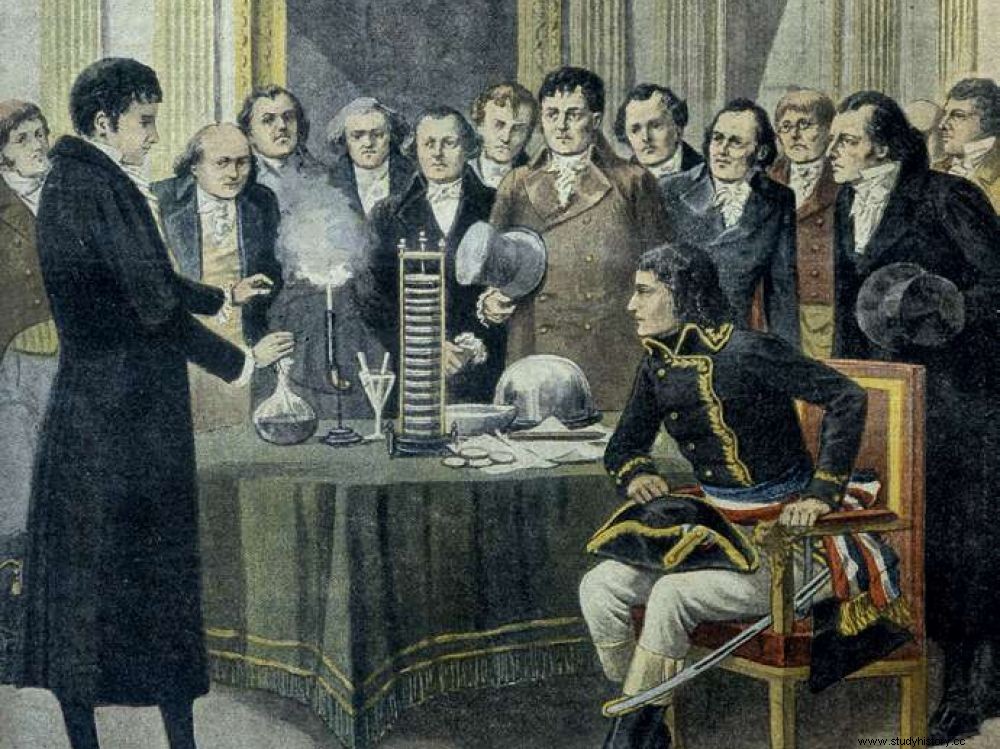
Physicist Alessandro Volta presented his electric battery to Napoleon in 1801.
This article is from the magazine Sciences et Avenir - La Recherche n°891 dated May 2021.
"A lot of science, so much intelligence and too much bravery, that's a weak sketch of this rare officer." It is in these terms that the visionary General du Teil de Beaumont expressed himself when evoking the young Bonaparte, the day after the capture of Toulon, against the English, in December 1793. All his life and from an early age , at the military college of Briennele-Château (Aube), Napoleon was passionate about the sciences and their potential in an era that was particularly favorable to them. "Napoleonic France was an empire of science, dominating Europe to a point that it is difficult to imagine today" , wrote in 2015 the chemist and historian Éric Sartori in his book The Empire of Sciences, Napoleon and his scientists . The nation was heir to the Enlightenment and great names reigned over their disciple:Pierre-Simon de Laplace (1749-1827), in astronomy, physics and mathematics; Abbé René Just Haüy (1743-1822), on mineralogy and crystallography; François Arago (1786-1853) on light and sound; while Bernard-Germain de Lacépède (1756-1825) and Louis Jean-Marie Daubenton (1716-1799) continued the work of the naturalist Buffon. And all of them were supported by Napoleon.
While he closely follows the progress of research by his physicist and mathematician friends, he is just as attentive to innovations. Thus, the construction of such a mill, mining machine or cartographic work caught his attention. The raising of the plan of the mouths of Kotor, in Montenegro, is a good example. To find out if warships could anchor along the coasts of the Adriatic, Napoleon asked the civil engineering and military engineers to draw up plans of extraordinary precision. The 4 x 2 meter map remains admirably preserved. It restores topographic data taken by hydrographic engineers when probing the seabed. "A good sketch is better than a long speech" , said the man in a hurry. This is evidenced by these plans and maps kept in the funds of the Imperial Secretariat of State and which are the subject of the exhibition "Drawing for Napoleon" presented until July 19, 2021 at the National Archives, in Paris, as part of of the commemoration of the bicentenary of the death of the Emperor.
This article is from the magazine Sciences et Avenir - La Recherche n°891 dated May 2021.
"A lot of science, so much intelligence and too much bravery, that's a weak sketch of this rare officer." It is in these terms that the visionary General du Teil de Beaumont expressed himself when evoking the young Bonaparte, the day after the capture of Toulon, against the English, in December 1793. All his life and from an early age , at the military college of Briennele-Château (Aube), Napoleon was passionate about the sciences and their potential in an era that was particularly favorable to them. "Napoleonic France was an empire of science, dominating Europe to a point that it is difficult to imagine today" , wrote in 2015 the chemist and historian Éric Sartori in his book The Empire of Sciences, Napoleon and his scientists . The nation was heir to the Enlightenment and great names reigned over their disciple:Pierre-Simon de Laplace (1749-1827), in astronomy, physics and mathematics; Abbé René Just Haüy (1743-1822), on mineralogy and crystallography; François Arago (1786-1853) on light and sound; while Bernard-Germain de Lacépède (1756-1825) and Louis Jean-Marie Daubenton (1716-1799) continued the work of the naturalist Buffon. And all of them were supported by Napoleon.
While he closely follows the progress of research by his physicist and mathematician friends, he is just as attentive to innovations. Thus, the construction of such a mill, mining machine or cartographic work caught his attention. The raising of the plan of the mouths of Kotor, in Montenegro, is a good example. To find out if warships could anchor along the coasts of the Adriatic, Napoleon asked the civil engineering and military engineers to draw up plans of extraordinary precision. The 4 x 2 meter map remains admirably preserved. It restores topographic data taken by hydrographic engineers when probing the seabed. "A good sketch is better than a long speech" , said the man in a hurry. This is evidenced by these plans and maps kept in the funds of the Imperial Secretariat of State and which are the subject of the exhibition "Drawing for Napoleon" presented until July 19, 2021 at the National Archives, in Paris, as part of of the commemoration of the bicentenary of the death of the Emperor.
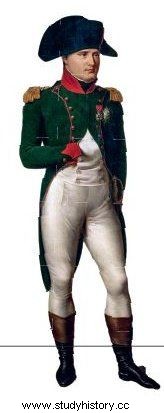
(JOSSE/ LEEMAGE)
Led by Hugues-Bernard Maret (1763-1839), Duke of Bassano, the Secretariat of State was an essential cog in the Napoleonic administration. This is where all communications, economic growth and urban development projects are saved. Those implemented or planned to develop France and recover it from wars and the Revolution. Teeming with innovations, they are all inevitably presented to Napoleon. Nothing escapes the Emperor, at the head of a centralized state with a pyramidal organization. "We know that he slept little, that he was kept informed of everything and that all these plans passed through his hands. Even when he was on the battlefield. Including during the Russian campaign! Ordinances traveled all over Europe to bring them to him!" , says Marie Ranquet, curator of the exhibition. Hugues-Bernard Maret then his successor, Pierre Daru (1767-1829), gathered for the emperor all the information from the four corners of the Empire. The same was true for his scientific readings. While Napoleon was in Vitebsk (Belarus), at the beginning of the Russian campaign, in July 1812, he received from his friend Laplace his Calculation of probabilities . Whatever the situation, Napoleon never traveled without his "flying libraries".
Among the innovations that the Emperor was able to exploit and develop was, for example, the optical telegraph by Claude Chappe (1763-1805), set up in 1794 between Lille and Paris. It made it possible to transmit information quickly to the most remote regions of the Empire thanks to a network of semaphores.
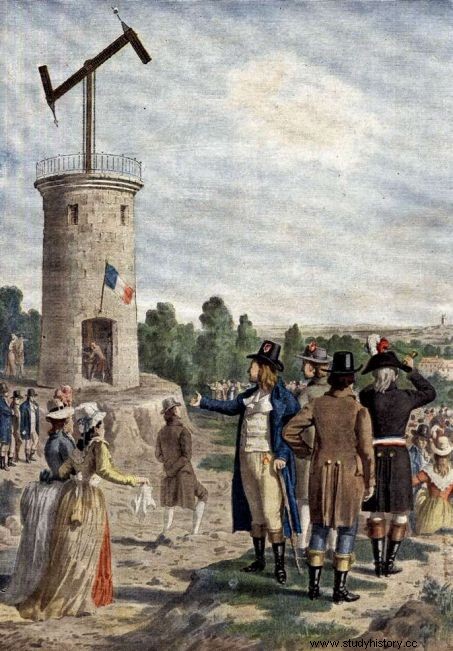
The Chappe Telegraph made it possible to connect the most distant regions of the Empire. (PVDE/BRIDGEMAN IMAGES/LEEMAGE)
We can also mention his interest in aerostats (read the box below), appeared in 1783. The model of an aerostatic machine project with its shrouds and nacelle was also able to be reconstructed by the Pras workshop, a company specializing in the restitution of prototypes, within the framework of the Parisian exhibition, from very precise measurements of the engineers of the time. "None have been retouched, insists Marie Ranquet. All elements of the aerostat reconstructed in 3D fit together perfectly!" Wherever he went, Napoleon always surrounded himself with men of science, and never were scholars so honored (nor so well paid) as under his reign. "He considered that discoveries were a means of making France shine, and science and technology a means of improving the lives of the French people" , says Marie Ranquet. Many scientists are indeed at the origin of the birth of the industrial power of post-revolutionary France, where rewards finance innovations. In 1801, the National Industry Encouragement Society was created, which aimed to bring together learned elites around an industrial development project.
The flight of the balloons
With the balloon flight of the Montgolfier brothers, in 1783, the human being rose in the air for the first time. Very quickly, scholars will seek to improve aerostation. Flying machine projects are multiplying, encouraged by scientific advances. As early as 1784, a young engineering officer, Jean-Baptiste Meusnier de La Place, offered the Academy of Sciences a machine in the shape of a rugby ball, equipped with a nacelle and propellers to control its movements. Hot air balloons, the first aerostats, are indeed difficult to maneuver (it is even their main problem), which compromises their use as a means of transport. Gaspard Monge, in 1808, thus advised Napoleon not to follow up on the unrealistic project of invading England by 100 aerostats proposed by the engineer Nicolas Lhomond... The military applications of the invention were limited to the use of tethered balloons to observe the battlefield. It was not until the end of the 19th century that the first airships were maneuvered and aeronautics was truly born.
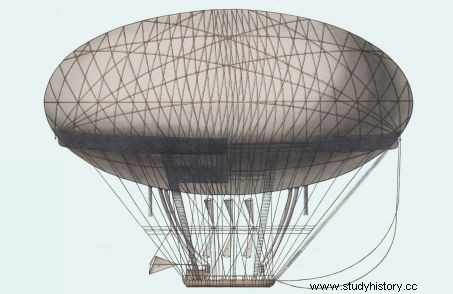
This "aerostatic machine", imagined by Jean-Baptiste Meusnier de La Place in 1784, was among the documents of the Imperial State Secretariat. A model was made for the "Drawing for Napoleon" exhibition at the National Archives. (NATIONAL ARCHIVES - PRAS WORKSHOP)
It is therefore quite natural that Napoleon also entrusts the highest political functions to the scientific elites. The chemist Antoine-François Fourcroy (1755-1809) became Director General of Public Instruction and Councilor of State; Jean-Antoine Chaptal (1756-1832), also a chemist, Minister of the Interior under the consulate; the mathematician Joseph Fourier (1768-1830), more famous for his "transforms" (the frequency representation of non-periodic signals), designated to accompany the expedition to Egypt (1798-1801) will be appointed in 1802 prefect of Isère where he will create the University of Grenoble. This campaign was moreover one of the most extraordinary scientific expeditions led by France and whose relative military failure was eclipsed by the incredible number of discoveries made by the 167 French scholars of the Commission des sciences et des arts who accompanied General Bonaparte on the banks of the Nile. The whole will be compiled in the 23 volumes of the Description of Egypt , one of the most monumental works ever made.
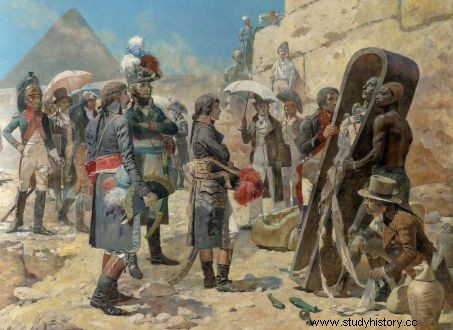
167 scholars accompany the army during the Egyptian expedition (1798-1801) led by General Bonaparte. The readings are then linked in the tombs and temples. The discovery of the Rosetta Stone and its subsequent deciphering by Champollion thus mark the beginnings of Egyptology. (JOSSE/LEEMAGE)
A supporter of vaccination
If mathematics was Napoleon's great passion, the emperor was also very open to medicine. He was not afraid of the plague-stricken:it is said that he approached seriously ill patients without the slightest hesitation. He openly supported vaccination:in 1811, he had his son, the King of Rome, barely 2 months old, vaccinated against the scourge that was then smallpox.
Town planning does not escape its desire for novelty
Demography, geography, agricultural and mining resources..."Napoleon wanted to know everything and control everything" , continues Marie Ranquet. Not only by political calculation. Mainly by taste. And for him, governing is only possible with detailed knowledge of the territory. So that the armies could pass, he had roads laid out or improved, such as that of the Simplon Pass in the Alps, bridges built, tunnels or canals dug, following all the works in person. Some plans kept in Paris still have annotations by Napoleon:"ask for a quote" , can we read on one of them.
Town planning and architecture are not forgotten. Several maps show how certain towns were to be completely transformed. Thus, Pontivy, in Morbihan, which was renamed Napoléonville! According to historian Éric Sartori, "after the fall of the Empire, Napoleon dreamed of leaving for America to begin a career as a traveling geophysicist like that of Alexander von Humboldt. But it was at Sainte-Hélène that he would end his days, not without having brought with him Buffon's Natural History, Delambre's Astronomy, Haüy's treatises on cosmogony, those on chemistry by Fourcroy as well as the course of Lacroix, which he annotated with his own hand."
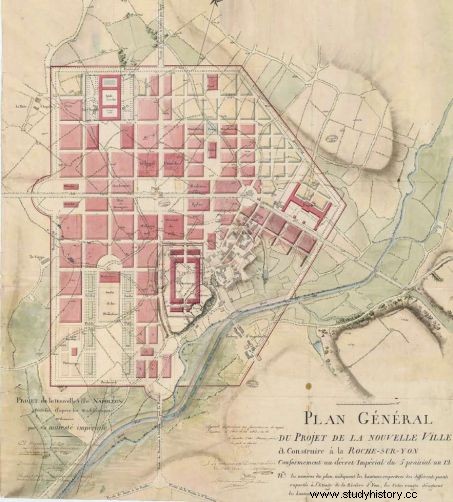
La Roche-sur-Yon, capital of the Vendée, was founded by Napoleon in 1804. The town is built on a checkerboard plan with its prefecture, high schools, barracks, and a hospital. (REMI CHAMPSEIT/NATIONAL ARCHIVES)
